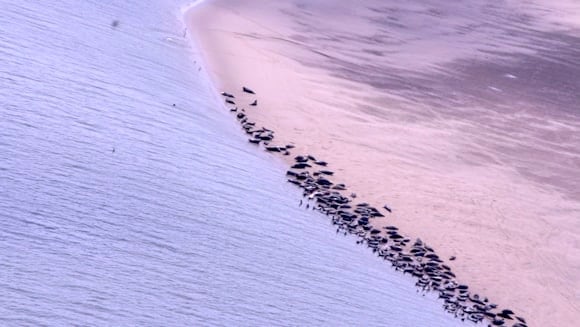Natural Resources Wales has reported the findings of the first complete aerial census of seals around the entire coast of Wales.
Seals haul out on rocks and sandbanks for a few hours around low tide, but they are scattered around the coast and on offshore skerries and islands.
Over three days early last August, the entire coast of Wales and all offshore rocks and Islands were surveyed using light aircraft.
All seals hauled out on the shore were photographed and counted, and the count was scaled up to estimate the total population size.
NRW, Natural England and the Joint Nature Conservation Committee commissioned the Sea Mammal Research Unit to carry out the survey, which was co-ordinated with similar surveys of Scotland and the east coast of England.
Wales has three marine Special Areas of Conservation with protected populations of Atlantic grey seals, Halichoerus grypus, and the survey has provided more information about these populations.
Grey seal population size in Wales is usually estimated from the number of pups born in the autumn each year at Welsh colonies.
But outside the pupping season, grey seals disperse widely, often travelling hundreds of kilometres to spend most of the year at distant feeding sites.
While some grey seals may move out of Wales after pupping, it is thought that seals also move into Welsh waters from elsewhere.
This survey took place in the summer, prior to pupping time, to estimate how many seals were feeding in Welsh waters rather than just those that raised their young at Welsh colonies.
Dr Thomas Stringell, a Lead Specialist Advisor on marine species at NRW said: “Although there is information from pup counts from some of the larger breeding colonies in Wales, there is sparse information for many seal haul-out sites in Wales, with no data since the 1990s for several.”
Although Grey Seals are found throughout Wales and south-west England, they are thought to only make up about 4% of the total UK breeding population, with Scotland and the east of England being pupping hotspots for the marine mammal.
Another species of seal, the harbour (or common) seal, despite its name is not commonly found in Wales.
“The aerial survey counted 1313 grey seals at 58 separate haul-out sites around Wales. Most (70%) were found along the North Wales coast, and the remaining 30% were concentrated along the Pembrokeshire coast,” continued Dr Stringell.

“We believe that only about 25% of seals will be hauled out and available to be counted – the rest being at sea. So, the count represents a total population of at least 5300 grey seals.
“At haul-out sites where previous August counts are available, for example in North Wales, the data suggest that the number of grey seals in ‘summer’ has increased by around 65% over the past 20 years.”
“The results from the aerial photographs and counts are now being further analysed by experts on seals and we are hopeful it will lead to a much better understanding of the population of seals we have in Wales.”




